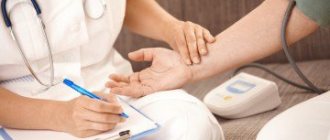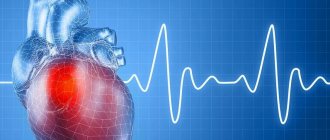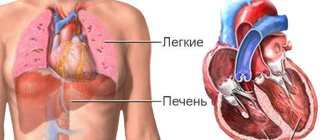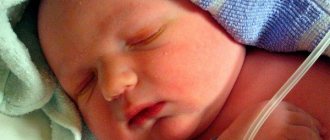Consequences
The main function of the heart is to pump blood through itself. Normally, it contracts evenly, but sometimes it fails and chaotic, heterogeneous contractions are observed. In these cases, the heartbeat can increase to a frightening figure - 600 beats per minute! Not surprisingly, the consequences can be very different. These include:
- Thromboembolism . For a clearer explanation, a comparison is suitable: blood is not pumped as it should be, but is churned in the atria. This is how blood clots form. They can be located in any part of the heart and begin to move at any moment. Embolization of the heart, that is, its blockage, is what happens as a result of the advancement of a blood clot or its fragment. The consequence of this can be a heart attack or stroke that can be fatal. The most dangerous can be called pulmonary artery thrombosis; there is almost 100% mortality, unless timely qualified assistance is provided. If the blood clot manages to get through the bloodstream outside the heart, into the systemic circulation, this is fraught with no less sad consequences. When it enters the blood vessels of the brain, for example, a stroke occurs . This pathology cannot but affect the patient’s quality of life: mobility is lost or severely limited, speech is impaired, the person loses the ability to work and the ability to self-care. Then long-term treatment, serious care, rehabilitation are required, and this is not a guarantee that all functions will return in full. If a large trunk of the Circle of Wellis is blocked by a blood clot, then coma develops . When a blood clot gets stuck in the intestinal mesentery, it causes necrosis . It is also dangerous for blood clots to get into the vessels of the extremities; this threatens the development of gangrene. If changes in this limb turn out to be irreversible, then amputation will be indicated.
- Heart failure , on the contrary, is a small number of contractions. In fact, the heart is not fulfilling its purpose of pumping. The entire body feels the consequences of this, since it can no longer receive oxygen and nutrients in the required amount. A variety of diseases can occur, often not even related to the heart.
- Bradycardia
is a fairly rare consequence of arrhythmia.
This condition is characterized by a critical decrease in heart rate to 40 or less. In this case, the brain and other organs receive a tiny amount of blood, which causes frequent fainting. The only thing that can help here is to install a pacemaker, which will be set to a normal heart rate - at least 60 beats per minute. This device is unique in that it begins to work only when the natural heart beat drops below 30-40 beats. - Tachycardia is the complete opposite of the previous condition. The rhythm in this case accelerates over 90 beats. The person begins to feel uncharacteristic, excessively frequent contractions. Moreover, this does not require any additional measurements - just put your hand on the heart area or on the wrist. Sometimes you don’t even need to do this - the abnormal heartbeat is noticeable anyway. This is all the more obvious since normally cardiac activity remains invisible to humans. Due to tachycardia, relapses of arrhythmia often develop, up to its most dangerous forms, which can no longer be stopped with medication. Tachycardia is also very dangerous because it is actually an overload of the heart. Sometimes the heart can no longer cope with such a rhythm and myocardial hypertrophy occurs. That is, the size of the organ increases and it requires blood highly saturated with oxygen. For some period this is all compensated, but after that it leads to oxygen deficiency, then to ischemia and heart attack.
Heart rhythms with tachycardia and bradycardia
Types of disease
Failure of electrical activity of myocardial cells and disturbance of heart rhythm is called cardiac arrhythmia.
Factors that increase the threat of death:
- degree of neglect;
- severity of the course;
- age;
- background diseases.
To avoid death, you need to find the cause. There are 5 types of arrhythmia:
Why is each disease dangerous?
Sinus arrhythmia is the mildest type of the disease. Most often it appears in children and adolescents due to nervousness. It does not require special intervention and can go away on its own. But it can be a symptom of circulatory failure, brain tumors, anemia, infection. It can be dangerous for pregnant women.
Atrial fibrillation is one of the most dangerous of all types of heart disorders. The cause of the disease can be electric shock, large amounts of alcohol, stroke, stress, surgery, or drug overdose. Symptoms are: chest pain, heart failure, rapid heartbeat such as fibrillation (fluttering).
Heart block is a delay or complete stop in the process of conducting impulses throughout the myocardium. Incomplete transverse block is manifested by loss of heart sounds and pulse, and with complete blockade the pulse becomes less than 40 beats per minute, and may be accompanied by fainting and convulsions. It has serious consequences, such as cerebral ischemia, angina, heart failure. The mortality rate for this type is 90 percent.
Tachycardia, which occurs rarely, does not require treatment, but it is worth observing to eliminate the causes. If heart rate acceleration is observed frequently or constantly, there is a risk of developing ischemia, heart failure due to wear and tear, oxygen starvation or the development of asthma of the heart muscle. Even death may occur.
Symptoms of violation
People who already had heart pathologies are more susceptible to arrhythmia. Children and the elderly are at risk. Regular checking of blood pressure and heart rate makes it possible to promptly identify the disease and prevent it from developing. If you have these indicators, you should consult a doctor:
- dyspnea;
- frequent dizziness;
- chest pain;
- uneven heart function;
- sudden attacks of weakness.
Return to contents
Can the disease go away on its own (clinical cases)
Clinical case 1 . The disease, or rather its individual types, can go away on their own. A clear example of this is sinus arrhythmia in children and adolescents. This rhythm disturbance occurs very often at this age, even against the background of complete health due to stress or severe anxiety. Sometimes this condition does not even require correction with medications. Of course, it is very important here not to miss the recognition of alarming symptoms and to ensure that the disease does not affect the child or teenager’s studies, sports and full life. With sinus arrhythmia, the heart rate remains within normal limits (60-90 beats), but their frequency is variable. This causes an abnormal heart rhythm to develop. It is very important to control this condition in a child.
Clinical case 2 . In adulthood, arrhythmia may disappear after recovery from the disease that caused the arrhythmia. For example, vegetative-vascular dystonia can often be the cause. After completing a course of treatment for this disease by a neurologist, heart problems cease to bother me.
Clinical case 3 . It also happens that the disease is provoked by bad habits and stress. After normalization of the rhythm of life, problems with arrhythmia disappear.
In other cases, the disease may weaken its symptoms or go away completely only after treatment with drugs or surgery.
Treatment of arrhythmia with folk remedies
Important! You cannot prescribe treatment for yourself. Before treatment, be sure to consult your doctor, because... Even folk remedies can harm the body!!!
Read also Sinusitis. Description, causes, prevention and treatment of sinusitis
Valerian infusion. 1 tbsp. Pour a spoonful of crushed valerian root into 1 glass of boiled water (room temperature). Leave in a sealed container for 8-12 hours, strain and take 1 tbsp. spoon 3-4 times a day.
Valerian decoction. Pour 2 teaspoons into 100 ml of water, boil for 15 minutes and take 1 tbsp. spoon 3-4 times a day before meals.
Calendula infusion. Pour 2 teaspoons of calendula flowers with 2 cups of boiling water, let stand for 1 hour and strain. Drink 0.5 glasses 4 times a day.
Melissa infusion. 1 tbsp. Pour 2.5 cups of boiling water over a spoon, let stand for a couple of hours (wrapped up) and strain. Drink 0.5 glasses 3-4 times a day. Take weekly breaks once every 2 months.
Hawthorn tincture. Pour 10 g of dried hawthorn fruit into 100 ml of vodka and leave to brew for 10 days. Strain and take 10 drops with water 3 times a day before meals.
Decoction of hawthorn flowers. Pour 5 g of hawthorn flowers into 1 cup of boiling water, cover with a lid, heat in a water bath for 15 minutes, cool and strain. Drink 0.5 glasses 2-3 times a day 30 minutes before meals.
Radish juice with honey. Mix fresh juice of black radish and honey in a 1:1 ratio. Take 1 tbsp. spoon 2-3 times a day.
Horsetail infusion. 1 tbsp. Pour 400 ml of boiling water over a spoonful of dry crushed horsetail herb, let it brew for 2 hours and strain. Take 1 tbsp. spoon 5-6 times a day.
Snack for arrhythmia. Grate the celery, add parsley, dill, mayonnaise and a little salt. Eat the resulting mixture once a day, before dinner. This delicious medicine can be eaten separately, or spread on bread.
Onion with apple. Chop a small onion and 1 apple. Mix and take between meals 2 times a day for 1 month.
Is it possible to die
Yes. But to be more precise, people die not from arrhythmia itself, but from the consequences that certain types of it bring to the body. For example, extrasystole can lead to cardiac arrest . Here everything depends on the presence of paroxysmal tachycardias and the body’s response to drug treatment. Sudden mortality is most likely for patients with organic heart disease.
Atrial fibrillation is no less insidious - it can cause ischemic stroke, which very often causes death. An equally dangerous consequence of this type of arrhythmia is pulmonary edema .
This type of arrhythmia is also characterized by the fact that the symptoms are not always obvious. The manifestations that arise can easily be confused with signs of milder types of arrhythmias. The death of a patient often occurs precisely because of this, as well as because assistance was provided untimely, incorrectly, or incompletely. It is very important for patients with atrial fibrillation to monitor their condition and be constantly monitored by a doctor.
Diagnosis of arrhythmia
Some types of arrhythmia are absolutely not noticeable by humans, so they can be identified using such types of diagnostics as:
— electrocardiography (ECG); - echocardiography; — daily or multi-day ECG monitoring; - Ultrasound.
Read also Prostate adenoma - symptoms, causes, diet and treatment
The most important method for diagnosing arrhythmia is, of course, an ECG. But it cannot always show arrhythmia, since it shows the heart rate only for the period of time in which it is written, and attacks of arrhythmia can occur suddenly and be short-lived.
How long and how do they live with this disease?
A person cannot help but worry about the question of how to live further with a diagnosis of arrhythmia. A correct and timely diagnosis is already half the battle. Then it is very important to strictly adhere to the recommendations of your doctor. If it is necessary to install a pacemaker, it must be installed. If medications are prescribed, they must be taken regularly, or during attacks, as prescribed by the doctor. The disease, diagnosed early, can be treated very effectively, which can significantly improve the patient’s quality of life. To maintain this level, it is important to adhere to a healthy lifestyle and give up bad habits. It is known that nicotine significantly increases the likelihood of developing various heart pathologies. It is equally important to strengthen the heart. This can be done by jogging in the fresh air, especially in the evening, fitness, shaping and other techniques. The diet plays a huge role - it must be rich in vitamins and all the necessary microelements. Patients with arrhythmia should lead a measured life, without severe nervous shock, conflict situations and stress.
Healthy lifestyle rules
Arrhythmias are conventionally divided into two parts: favorable for life prognosis and unfavorable. In the latter case, medicine does not cure the disease, but only improves the prognosis and the person’s standard of living. No doctor can accurately predict life expectancy. According to recent studies, the average life expectancy in Russia is 70 years. Even with arrhythmia, with the correct treatment procedure and adherence to recommendations, there is every chance of overcoming this age level.
Can it lead to death?
Deaths in people who were in stable condition but died within an hour of the onset of the attack without further symptoms are called "sudden cardiac death." You can die from arrhythmia due to cessation of blood circulation. Patients with coronary heart disease die more often. People at risk include people without visible heart damage, but who may experience idiopathic ventricular fibrillation (with unknown causes). Additional factors that indicate problems:
- myocardial enlargement;
- myocarditis;
- long QT syndromes;
- bicuspid valve prolapse;
- cardiomyopathy.
Return to contents
Do they give disability
|
Also, in some cases, disability is due to the installation of a pacemaker. For example, when after its installation a person cannot work at his previous job due to contraindications. Or if, after the introduction of the pacemaker, complications arose, the condition worsened, and arrhythmia attacks became more frequent. Also, temporary disability occurs due to various postoperative complications. The second group is indicated when the pacemaker is ineffective.











